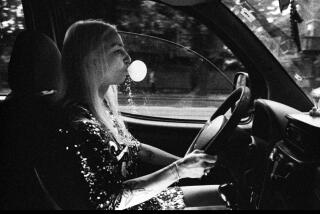The culture war started 30 years ago by Martin Scorsese’s ‘The Last Temptation of Christ’ is alive today
He came out of a sandstorm, bloody and battered, an earthen and flawed Jesus who 30 years ago set off a culture war over questions of faith and the divide between artistic freedom and Christian scripture.
Martin Scorsese’s “The Last Temptation of Christ” was a meditation on a messiah tormented by inner doubts and moral reckonings until he found transcendence on the cross. The portrait of a spiritually uncertain Jesus (Willem Dafoe) ignited protests from evangelicals and Catholics over a scandalous, if quite human dream sequence, in which the son of God is tricked by Satan to escape crucifixion, marry Mary Magdalene and raise a family.
Shouts of blasphemy rang out over sex scenes and what Southern Baptists vilified as a “wimpy” Christ. The film jolted the American conversation on religion, art and politics in the same year that President Reagan signed a proclamation for a national day of prayer and the Cold War, propelled by a good-versus-evil ethos, was nearing its end. Much like today, when evangelicals vet Supreme Court nominees and remain crucial to President Trump’s base, the nation was confronting existential questions and the tug of God on daily life.
Scorsese has long mapped the searching soul. His films — “Taxi Driver,” “Raging Bull” and “Silence” — balance the sacred and the profane. His philosophical explorations of the vast, unsettled terrain between the human and the divine stem from a boyhood Catholicism and its teachings of devotion and selflessness. Based on the 1955 novel by Nikos Kazantzakis, the Jesus in “Temptation” is a fallible carpenter. He hears voices and is bewildered by who he is; his faith strengthens in degrees and doesn’t crystallize until the end.
“This is Hollywood’s worst hour.”
— The Rev. Jerry Falwell
The Catholic Church rated the film “morally offensive.” Some Jewish leaders saw it as anti-Semitic. Picket lines went up in Los Angeles and New York. The Rev. Jerry Falwell, a television evangelist and leader of the Moral Majority, a political action group, said: “This is Hollywood’s worst hour. Neither the label ‘fiction’ nor the First Amendment gives Universal [the studio] the right to libel, slander and ridicule the most central figure in world history.”
That sentiment echoes today in skirmishes between liberals and the Christian right over immigration, abortion, gay rights and the furor around Trump’s conservative Supreme Court nominee, Brett Kavanaugh. Since its founding, this country has been a battleground between religion and secularism, and ironically, Trump, like Reagan in the days of “Temptation,” has become a hero of evangelicals despite his unholy tweets and alleged payoffs to a stripper and a Playboy Bunny.
Invoking God is as common as courting lobbyists. Atty. Gen. Jeff Sessions cited Apostle Paul in warning immigrants not to cross the border illegally; former EPA Director Scott Pruitt said Trump was elected president because of “God’s providence.” Trump pleased evangelicals at this year’s national prayer breakfast, saying: “Our rights are not given to us by men, our rights are given to us from our creator. No matter what, no earthly force can take those rights away.”
In her book “The Evangelicals: The Struggle to Shape America,” Frances FitzGerald writes that evangelicals are “the most American of religious groups, and during the nineteenth century they exerted a dominant influence on American culture, morals and politics. By the mid-twentieth century the United States was becoming a more secular nation, but since 1980 many evangelicals, led by the Christian right, have struggled to reverse the trend… they have reintroduced religion in public discourse, polarized the nation, and profoundly changed American politics.”
That is the terrain Scorsese and screenwriter Paul Schrader encountered when “Temptation” opened in 1988. The following is an email conversation with Scorsese about the 30th anniversary of the film and his cinematic and spiritual evolution.
The Jesus in “Last Temptation” is a tormented messiah who discovers his faith and identity in gradations. His spiritual journey is quite human. The power of the film is that it forces self-reflection over one’s struggles with faith, something experienced by most believers. Were you surprised at the reactions from Christian conservatives?
I was driven to make “Last Temptation” because I wanted to look at questions of faith and penance and redemption within the context of the world right now, with all the formalities stripped away. I’m constantly exploring this question in my pictures and in my life.
I’m a great admirer of many of the older Hollywood pictures about the life of Christ that I saw when I was young, but the limitation of those films is that they tell the story as if it were a pageant. It’s like looking through an illustrated storybook — you leaf through the pages and look at all the familiar images and read all the familiar passages and everything is several layers removed from what’s happening in your life right now.
I was trying to start a dialogue. I didn’t want to just make a picture for people who were secure in their faith. Christ’s teachings are about all of us — the secure and the insecure, the powerful and the powerless, the down and out, the addicts, the people in real pain, the people caught in states of delusion, the ones who feel absolutely hopeless and see no possibility of grace or redemption. Because the afflictions of “the least among us,” as Jesus said, the inner circumstances that lead to their fall, are in everyone. I wanted to make a picture about a historical figure named Jesus, a spiritual guide, but also … a human being, surrounded by other recognizable human beings, as opposed to wax figures.
Did I think it would be accepted by everyone? Not necessarily. But I hoped it would. I knew that everyone wouldn’t embrace it, but I thought they just might. And what happened was that the picture was vilified by people who made a cultural show of their vilification, and many of whom not only hadn’t seen it but vowed to never see it. And that saddened me.
You once thought about becoming a priest. Much of your work is imbued with the spiritual, the place where the grace of God intersects with the deeds of men. Faith is constantly challenged. How has your faith evolved over time? And how have you dealt with those iterations in your films?
When I was young, I had a child’s understanding of Catholicism, and the idea of God is somewhat like an ultimate parent — if you were good, you would be rewarded with his love, and if you were bad, you would be punished with hellfire. When I read Joyce’s “A Portrait of the Artist as a Young Man,” it had a profound effect on me. It was a liberating experience.
I also had a remarkable teacher, a priest named Father Principe, who would give us all the standard lessons about the wages of sin, but who set a different kind of example with his words. He advised us, sometimes cajoled us, truly guided us, and he had such an extraordinary love.
In the late ’60s, when the country was in the middle of a moment even more dramatic and upsetting and confusing than the one we’re living through now, I remember seeing [Robert] Bresson’s adaptation of “Diary of a Country Priest” for the first time. That picture is based on a novel by [Georges] Bernanos, and absolutely every character in the novel and the film is suffering. But at one point, the priest says, “God is not a torturer. He just wants us to be merciful with ourselves.”
That opened my eyes. We feel that God is torturing us and punishing us, but when we give ourselves the peace to reflect, we come to understand that we are our own torturers and that we mete out our own punishments. So mercy begins with ourselves. Mercy, acceptance, charity, kindness and love. And I believe that started me on a road that I’ve been on ever since — trying to understand who I am in relation to my faith, why I wanted to become a priest and then realized that it was not my vocation, then coming to terms with the fact that I was a filmmaker.
I’m not saying that I always succeed, but I’m always trying. You can see it in my pictures from the start, with “Mean Streets.” “You don’t pay for your sins in church,” says Charlie, first thing in the picture. “You do it in the street.” In some pictures, you can see it clearly — “Mean Streets,” “Raging Bull,” “Last Temptation,” “Casino,” “Silence.” For me, over the years, it’s where I’ve found my unifying thread.
The root of faith — as Jesus discovers in “Last Temptation” — is selflessness. How do we achieve that in a world that runs so counter to that notion?
You know the Bob Dylan song from “Infidels,” “Man of Peace”? “You know that sometimes Satan comes as a man of peace…” In other words, the people who make a show of their generosity, who draw attention to the wonderful acts they’ve performed and the money they’ve given away, who are always looking for reflections of themselves in the eyes of others. [This] runs counter to the deepest experience of being human, the understanding that without “us” and everything around us, “me” is not possible. To make a show of your generosity is not to be generous. Generosity and compassion are there at your core. They’re basic to humanity.
But life is tumultuous. It’s filled with temptations, and with them, greater temptations to just give up, a kind of spiritual exhaustion: “I guess this is all there is, so I might as well grab as much of it as I can.” So you try to keep the rudder straight, maintain your core values and acknowledge your failures and weaknesses, accept them, try to improve, and then you learn.
Does the world really run counter to selflessness? Or is it just that we’re now living through a moment in which so many people are making a show of selfishness, loudly and consistently?
If you had to distill the meaning of “Last Temptation” into one scene, which scene would it be?
I think it would be the scene where Judas comes to summon Jesus back from the dream. Willem was so remarkable in the passage where Jesus, as an old man who has lived a long, happy life, says that in the end, he does want to be the Messiah. We were under so much pressure with that picture, and Willem was in makeup for six straight hours, and we had no time, and we shot it and we just weren’t comfortable with it. And we went back the next day, really up against it, and he did it in one take. It’s the heart of the picture, so it had to be right. And it was.
See the most-read stories this hour »
Twitter: @JeffreyLAT
ALSO
‘Deep State’ conspiracies thrive in our messy and divisive cultural wars
Europe’s rising nationalism is putting pressure on film directors and the stories they tell
More to Read
Only good movies
Get the Indie Focus newsletter, Mark Olsen's weekly guide to the world of cinema.
You may occasionally receive promotional content from the Los Angeles Times.







